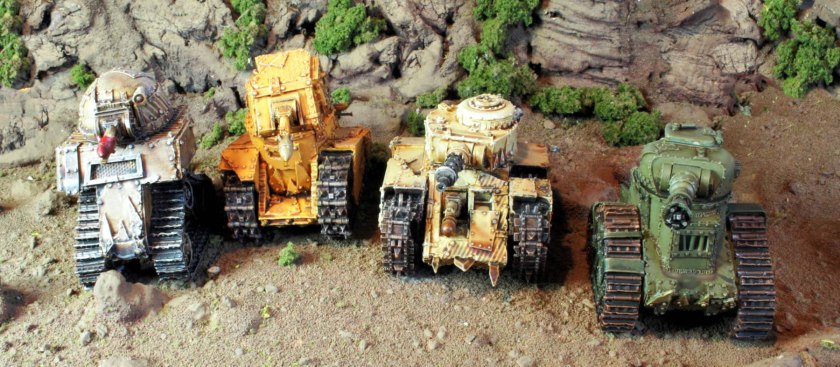These Imperial Knights were part of the displays at Warhammer World.
Year: 2020
T’au Devilfish Troop Carrier
This T’au Devilfish Troop Carrier was on display at Warhammer World.
A TY7 Devilfish armoured troop carrier is the primary anti-gravitic skimmer transport utilised by Tau ground forces and can carry twelve Fire Warriors or Pathfinders into combat in relative safety, and then provide mobile fire support once they disembark. A resilient and versatile transport, it is the TY7 Devilfish that allows Fire Caste ground forces to successfully execute many of their strategies, whether by rapidly relocating Fire Warriors to new coordinates as part of grand strategic manoeuvers, or punching through enemy lines, guns blazing, to extract Pathfinder teams before they can be overwhelmed. These ubiquitous transports are exceptionally popular with the Fire Caste, and their courageous pilots are offered great respect.
Necron Obelisk
Warhammer World Grot Tanks
In the Ork display cabinets of Warhammer World are the Forge World Grot Tanks.
The lunatic product of the deranged imaginations of grot riggers and scavs that have spent far too long basking in the insane genius of the Big Meks, Grots Tanks are diminutive armoured vehicles made to imitate the far larger Ork Wagons and Tanks.
I really liked these models and I bought them when they were released, but alas they spent many years on the Grot Tank workbench before this year when I got some real painting done and virtually finished all four tanks.
I think the next time I visit Warhammer World I might pick up another pack of the tanks and build different variants and maybe add some more details as well.
See the Grot Tank Miniatures Gallery for more photographs of these little tanks.
Necron Monoliths at Warhammer World
At Warhammer World there were a few Necron Monolith models on display. These photographs were taken in January 2020 before the lockdown and before the new model was released.
There is something very different and menacing about the Monolith and I do applaud Games Workshop for coming up with a very alien vehicle and not producing a stereotypical Terminator’esque tank.
A Monolith is a massive mobile fortress used by the Necrons as their primary planetary assault craft. A Monolith combines the properties of a transport craft, armoured destroyer and icon of undying Necron power. Its ponderous form can float across a battlefield upon its anti-gravitic engines, whilst its crystal core pulses with sickly energy that can be manipulated into powerful beams of Gauss lightning which whip out from its weapon mounts.
When its massive silhouette looms over a battlefield, it will lay waste to entire armies with strobing torrents of gauss fire and the deafening crack of its particle whip.Few armies can stand long before the immense firepower of a Monolith. Living troops are reduced to their component atoms by its punishing gauss flux arcs, while tanks rupture and explode in showers of molten steel as it focuses its energies upon them.
Morris Minor, Trabant, Land Rover and then some…
Ork Meka Dread
These modified Mega Dreads replace the big shootas with multiple tool-equipped servo-arms for battlefield ‘fixins’.
Visit the Ork Mega Dread Miniatures Gallery.
Ork Battlewagon
There was this Battlewagon.
A Battlewagon is a catch-all term used for any type of Ork assault tank and heavy armoured troop transport.

Here is another similar Battlewagon.
The term Battlewagon seems to refer overall to a category of large Ork armoured vehicles. A Battlewagon can be wheeled, tracked or a combination of the two and is used in many battlefield roles. It always carries a large complement of weapons.
See the Battlewagon Miniatures Gallery.
English Electric P1A
The first flight of P1 WG760 was on 4 August 1954, just 10 years after the RAF’s first jet aircraft, the Meteor, entered squadron service. It was experimental and was the basis for the RAF’s front line fighter, the English Electric (later BAC) Lightning. It was the first and only truly supersonic aircraft developed by Britain on her own.
In 1947 the proverbial back of an envelope design was so novel that the Ministry of Supply and the Royal Aircraft Establishment were deeply concerned as to whether it could succeed. Nevertheless, they placed an order for an experimental study. Two years later they placed a contract for two prototypes and an airframe for static testing.
Primary concern was the 60 degree sweepback of the wing and the low position of the tail plane. To have the concept independently tested they contracted Short Bros. to build the SB5, an aircraft whose wing sweepback could be changed and tail plane raised or lowered. In the event both the P1 and SB5 confirmed the concept.
WG760, the first of the two prototypes, exceeded the speed of sound in level flight, achieving Mach 1.22. The second prototype P1A WG763 reached a maximum of Mach 1.53.
Further developments of the fuselage and the fitting of more powerful engines meant that later aircraft exceeded Mach 2.0. The Lightning stayed in service for nearly three decades.


























